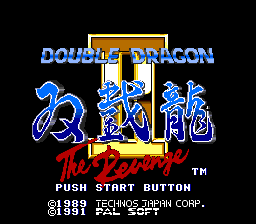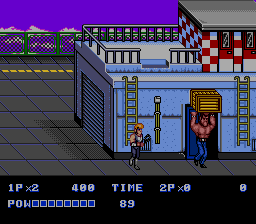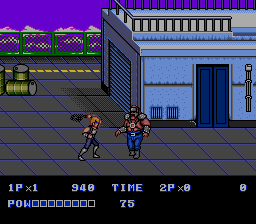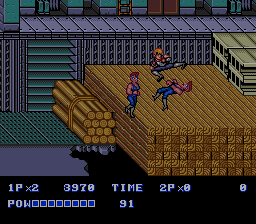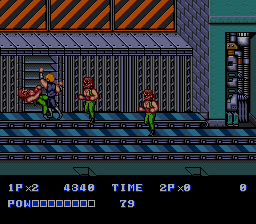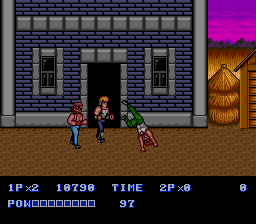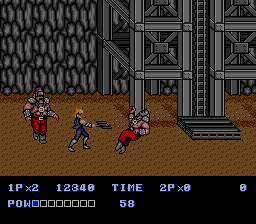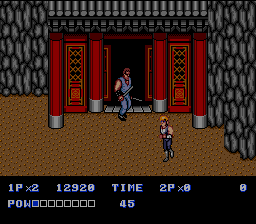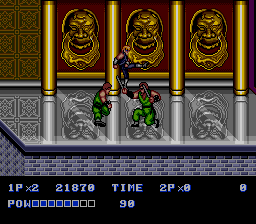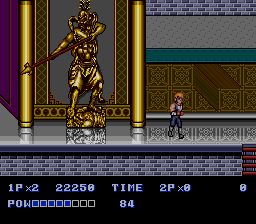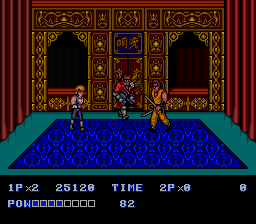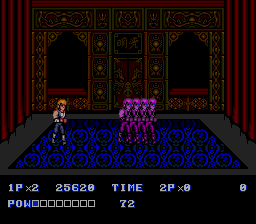Double Dragon II: The Revenge
From Sega Retro
| Double Dragon II: The Revenge | ||||||||||
|---|---|---|---|---|---|---|---|---|---|---|
| System(s): Sega Mega Drive | ||||||||||
| Publisher: PALSOFT | ||||||||||
| Developer: Quest[1] | ||||||||||
| Licensor: Technos | ||||||||||
| Original system(s): Arcade boards | ||||||||||
| Developer(s) of original games: Technos | ||||||||||
| Genre: Action[2][3] | ||||||||||
| Number of players: 1-2 | ||||||||||
| ||||||||||
|
Double Dragon II: The Revenge (ダブルドラゴンII ザ・リベンジ) is a Sega Mega Drive beat-'em-up game developed by Quest and published by PALSOFT. A port of the titular 1989 Technos arcade game Double Dragon II: The Revenge, it was released exclusively in Japan in December 1991.
Contents
Story
At the end of the 20th century, violence ruled the city after the nuclear war. The people of the city were living in fear of the Black Warriors, a criminal organization that has acquired tremendous influence. On the outskirts of the city also lived twin brothers named Jimmy and Billy Lee, who were running their own kung-fu gym.
One day, the Black Warriors were gathered on a certain spot after their usual rampaging of the city when a young woman accidentally stumbled into their meeting. The gang brutally murdered her without mercy. Her name was Marian, Billy Lee's girlfriend. With his older brother Jimmy, Billy sets out on a mission to get his revenge on the Black Warriors.
Gameplay
The game is a belt-scrolling beat-'em-up that can be played by one or two players. Player one controls Billy, who wears a dark blue outfit and has blond hair, while player two controls Jimmy, who wears white and has brown hair. The second player can join during gameplay by pressing START .
The brothers move around the plane using the D-Pad. Instead of having specific punch and kick buttons, the brothers attack to the left with ![]() and attack to the right with
and attack to the right with ![]() . They jump with
. They jump with ![]() . Pressing the front attack button while standing causes the character to throw a flurry of punches in the direction he is facing, while pressing the rear attack button kicks. While grabbing an enemy, the front attack button does repeated knee kicks, while the rear attack button performs a shoulder throw. Pressing the attack button at the peak of the character's jump causes the player to perform a whirlwind kick (旋風脚), which sends enemies from both sides flying away. Like in the previous game, certain enemies can be disarmed of their weapons and used against them and certain large objects can be picked up and thrown (using an attack button).
. Pressing the front attack button while standing causes the character to throw a flurry of punches in the direction he is facing, while pressing the rear attack button kicks. While grabbing an enemy, the front attack button does repeated knee kicks, while the rear attack button performs a shoulder throw. Pressing the attack button at the peak of the character's jump causes the player to perform a whirlwind kick (旋風脚), which sends enemies from both sides flying away. Like in the previous game, certain enemies can be disarmed of their weapons and used against them and certain large objects can be picked up and thrown (using an attack button).
The brothers have health meters and lose segments as they take damage from opponents. They lose a life if they lose all of their health but revive in place after a moment if the player has extra lives remaining. There are also some basic platforming sections in which characters can lose a life if they fall off the stage. Players also lose a life if the stage timer runs out. The game ends if the player runs out of lives but can be continued if there are credits remaining.
There are three difficulty levels (Easy, Normal, and Hard), and players can choose the number of starting lives (3, 4, or 5).
Stages
| ヘリポート (Heliport) | |
|---|---|
| The mission starts with Marian being gunned down by Willy. After Willy and his gang walk away off-screen, Billy (and Jimmy if a second player is present) emerge from the garage. | |
| 材木置き場 (Lumber Yard) | |
| 麦畑 (Wheat Field) | |
| ボスのアジト (Enemy Hideout) | |
History
Development
While the Mega Drive version has no official credits, it is known that the sound conversion was handled by Hitoshi Sakimoto. Masaharu Iwata, who composed the game over theme for this version, claims that Quest may had handled the actual conversion.
Versions
- The characters are designed on a much smaller scale than the arcade version. The Lee brothers, who were each 32x64 pixels tall in the arcade version when standing, are only 24x48 pixels in the Mega Drive version. Colors are also much darker. This was not due to the hardware limitations of the Mega Drive, as Accolade's port of the first game that was released in the west managed to preserved character scale of the arcade version, while later beat-'em-ups on the console such as Streets of Rage 2 displayed much larger characters in much greater numbers.
- The amount of on-screen enemies could go as large as up to eight enemies in the arcade version, whereas the Mega Drive tends to restrict itself to only two or three on-screen enemies at a time for each battle. The actual enemy placement is also very different in the Mega Drive, such as the second fight in Mission 1 being against a trio of Lindas, whereas there was only one Linda in this fight in the arcade version.
- The seamless transition sequences when the Lee brothers leave one stage to enter the next one are gone. Instead, the screen fades to black after defeating the stage boss and then cuts in to the start of the next stage. However, the intermission music can still be played during the options menu.
- The jumping reverse kick (performed by pressing jump and front attack simultaneously) is missing in the Mega Drive version.
- All the enemy characters from the arcade version are present, except for Jeff, a Lee brother clone who served as a sub-boss in Mission 3 and 4 in the arcade game. The Mega Drive simply substitute his appearances with more Lindas.
- The level designs for the stages are closed to the arcade version, except for Mission 2, which has a completely different layout: it is much longer and has several more conveyor belts and pitfalls to avoid.
- The Mega Drive version pauses for a second when certain enemy characters are killed just before playing their death scream. The Mega Drive version also has incompatibility issues with the Fighting Pad 6B, as it causes the player's character to move much slower than the standard control pad.
- Instead of a photograph of the Lee brothers with Marian, the ending is a black and white montage of Billy Lee fighting against the game's bosses.
Magazine articles
- Main article: Double Dragon II: The Revenge/Magazine articles.
Physical scans
| ExpandSega Retro Average |
|---|
| 40 | |
|---|---|
| Based on 19 reviews | |
Technical information
- Main article: Double Dragon II: The Revenge/Technical information.
References
NEC Retro has more information related to Double Dragon II: The Revenge
|
- ↑ @iwata1966 on Twitter (Wayback Machine: 2014-08-03 16:28)
- ↑ File:DoubleDragon2 MD JP Box.jpg
- ↑ Jump up to: 3.0 3.1 https://sega.jp/history/hard/megadrive/software_l.html (Wayback Machine: 2020-07-02 23:21)
- ↑ 1700 igr dlya Sega, "" (RU; 2001-xx-xx), page 61
- ↑ Beep! MegaDrive, "January 1992" (JP; 1991-12-07), page 80
- ↑ Consoles +, "Janvier 1992" (FR; 199x-xx-xx), page 40
- ↑ Console XS, "June/July 1992" (UK; 1992-04-23), page 129
- ↑ Cool Gamer, "9" (RU; 2002-10-13), page 66
- ↑ Computer & Video Games, "March 1992" (UK; 1992-02-15), page 66
- ↑ Famitsu, "1991-12-27" (JP; 1991-12-13), page 42
- ↑ Games-X, "16th-22nd January 1992" (UK; 1992-01-16), page 22
- ↑ Hippon Super, "February 1992" (JP; 1992-01-07), page 97
- ↑ Joystick, "Février 1992" (FR; 1992-0x-xx), page 148
- ↑ Mega Drive Fan, "March 1992" (JP; 1992-02-08), page 83
- ↑ MegaTech, "March 1992" (UK; 1992-02-20), page 40
- ↑ Mean Machines, "April 1992" (UK; 1992-03-28), page 106
- ↑ Mean Machines Sega, "October 1992" (UK; 1992-09-xx), page 138
- ↑ Power Play, "3/92" (DE; 1992-02-12), page 140
- ↑ Sega Pro, "February 1992" (UK; 1992-01-16), page 62
- ↑ Sega Pro, "April 1993" (UK; 1993-03-11), page 65
- ↑ Sega Opisaniy i sekretov, "14000 Opisaniy i sekretov" (RU; 2003-03-11), page 53
- ↑ Sega Saturn Magazine, "September 1995" (JP; 1995-08-08), page 87
| CollapseDouble Dragon II: The Revenge | |
|---|---|
|
Main page | Comparisons | Maps | Magazine articles | Reception | Region coding | Technical information | Bootlegs
Prototypes: 1991-10-18
| |
| CollapseDouble Dragon games for Sega systems | |
|---|---|
| Double Dragon (1988) | |
| Double Dragon II: The Revenge (1991) | Double Dragon (1992) | Double Dragon 3: The Rosetta Stone (1992/1993) | Battletoads/Double Dragon: The Ultimate Team (1993) | Double Dragon V: The Shadow Falls (1994) | |
| Double Dragon (1993) | |
